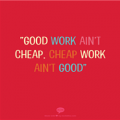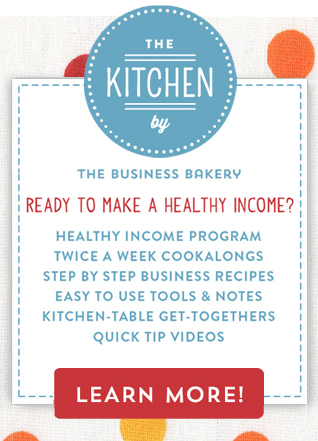Week 6 of the Eight Week Plan. Spend your Time doing Stuff you Enjoy
Written by Julia Bickerstaff // December 5, 2012 // Daily Juice // No comments
Let’s start by talking about profitable.
When you run a small business, it’s only profitable when you get paid fairly for your time. And your business gets more profitable when it pays you more fairly (or even generously!) for your time.
So, by my way of thinking a business that earns $40,000 a year for an owner who works 2000 hours a year (a rate of $20 an hour) isn’t as profitable as the business that earns the owner $20,000 for 500 hours work ( a rate of $40 per hour).
What “fairly’ means depends on you (and your workings from Week 1!) but if you’re working long hours and making not much in the way of money, it’s probably not fair.
In fact many small business owners are being paid completely unfairly as their rate per hour is significantly less than the minimum wage (of whatever country you’re in). Ugh.
Outsource
One of the best ways to improve the profitability of your business – and your sanity- is to ‘outsource’ some of the work you do.
Now, you might have recoiled when I said that. Not because you are a control freak – in fact there’s nothing quite as good as running a business and a family simultaneously to help one embrace as much help as possible – but because you might be worried that you can’t afford it.
We’ll look at that sticky little point in a minute. But for now let’s look at what you could and should outsource, as if you had, sigh, an unlimited budget.
The task rainbow
Here’s a simple and fun way to work out what you should and shouldn’t outsource.
To start with here’s a rainbow of the type of work you do, colour coded according to how much you like doing it and whether you even know how to do it!
Here’s what you do with it:
- In a notebook or worksheet head up the page into 5 columns like the ‘Task Rainbow’ above.
- Think of a typical week in your business, what are all the tasks that need doing? Pop each task under the heading in the task rainbow that’s most applicable. So if you love the task it goes in column 5 and if you hate it it goes in column 2.
- Now think about the stuff on your to do list. Are there are there any things lounging on there because you don’t know how to do them? Pop those in column 1.
- Are there any jobs you do that you struggle with because you’re a bit hopeless at them? (bookkeeping is a common one here!). Pop them down in column 3.
- Column 4 is for the things that you do over and over again, that are pretty simple and you might even quite enjoy, but probably don’t add much value to the stuff you’re selling. A good example here is packaging up sold goods and taking them to the post office!
- If you’ve got a very busy home-life, I think it’s perfectly fair – essential even – to pop some of the home jobs on the columns too -stuff like cleaning. Most will go under columns 2,3 and 4.
- Now look at your list:
- anything in column 1 must be outsourced to an expert, a good example might be your website redesign, or a legal contract
- anything in column 2 should be outsourced as soon as you can afford it (or even slightly before!). Work that drains you impinges on your feelings for the whole business and can mean that everything (even the good stuff) you do takes longer and feels harder.
- anything in column 3 that you outsource will really free up some time, so if you can afford it outsource the stuff in list 3 after you’ve done lists a) and b).
- column 4 tasks are perfect candidates for giving to a casual (and cheap) hire. Because the tasks are repeatable and simple you could even get kids to do them. Nowt wrong with a little child labour!
- Don’t. Not ever. Never. Outsource column 5. This is the stuff you enjoy. Do it.
Can I afford to outsource?
So now that I have whet your appetite for outsourcing, the question is “Can I afford it?”.
A better question is probably “Can I afford not to do it?”
- Column 1 tasks you simply have to find the money to do. These tasks should, when done, either make you money (like a website) or save you money (like legal advice). At the bottom of the worksheet in the ‘action’ box for column 1 pop down any of these task(s) you are going to outsource.
- Outsourcing tasks in columns 2, 3 and 4 is about freeing up your time so that you can do more of the profitable work (like the stuff in column 5). As a rule of thumb I think that if a task can be outsourced then you’re best off outsourcing it. There’s plenty of work in a small business that has to be done by the business owner so getting rid of the rest seems like a good idea. But that might seem like rather a large leap from where you are now, so let’s take a look at way to tell whether you can afford to do it.
Quick affordability sum
Not many people like sums so the idea here is that you use the thinking behind this rather than embark on a tortuous maths exercise! Gut feeling will serve you fine.
Let’s say that every time you sell an item you make a profit* of $150. And it takes you 2 hours to make an item and one hour to find a customer to buy it*
So it takes you three hours to earn $150, which means you make a profit of $50 an hour when you are doing revenue generating (which means making and selling the product, not admin) work.
Now let’s say it’s the end of the month and you are doing your bookkeeping. You know how to do it but it takes you ages – way longer than a professional bookkeeper. You normally set aside a day – 7 hours – to do the work. That’s 7 hours of ‘revenue’ generating work you don’t do…… which is worth $50*7=$350.
What would happen if you hired a bookkeeper instead?
The bookkeeper gets the job done much quicker than you! She does the work in 3 hours and at her rate of $45 an hour the cost is $135. Meanwhile you are doing 7 hours of revenue generating work and earning $350.
So instead of doing the work yourself and earning a big fat zero you could outsource your bookkeeping and earn $215 ($350 less $135).
How does that sound?!
* the profit is the selling price less costs of making, distributing, marketing and selling the product
** this means that if you spent 10 hours marketing and selling in a month and sold 10 items, it took you roughly one hour to sell one item
Quick tips
- If, when you work out your profit per hour, you get a really small number……one that makes it impossible to ever be able to afford to outsource anything then go back and look at Week 3, 4 and 5 because, ahem, it sounds like your pricing, waste or marketing is in need of a little love.
- You don’t need to actually employ the people you outsource to. Most of your work can be done by other self employed people who you only hire when you need them.
- Try doing the affordability sum on your home tasks too. Maybe it makes sense to hire a cleaner, for instance.
Finally
Now you know how to do the affordability sum, take a look at the tasks you’ve written down in columns 2, 3 and 4 and see which ones are most affordable to you.
A good idea is to rank the tasks you’d like to get rid of so that you’ve got a plan (I don’t expect you will do them all at once!) Make the task you most want to get rid of number 1 and number the rest of them in order of how desperate you are for them to go.
On your worksheet write the numbers down and at the bottom note down the next three task you’d like to outsource!
Last thought
Outsourcing stuff doesn’t just make sense from a profitability point of view. It also makes sense for your sanity. Getting rid of the work that stresses you frees your brain up to work so much more effectively on the stuff you enjoy!

Fancy getting a weekly Snack of sweet stuff for your small business? Just pop your details in below.






















